Poha dosa is amazingly soft, spongy, porous crepes or pancakes made with flattened rice, idli rice, curd and urad dal batter. Poha is flattened rice and dosa are crepes. Poha has various names. So these dainty fluffy pancakes take the first name of this hero ingredient aka poha and are also called as Atukula Dosa or Aval Dosa or Avalakki Dosa in regional South Indian languages. Serve them with Coconut Chutney or Sambar for a comforting breakfast or lunch.
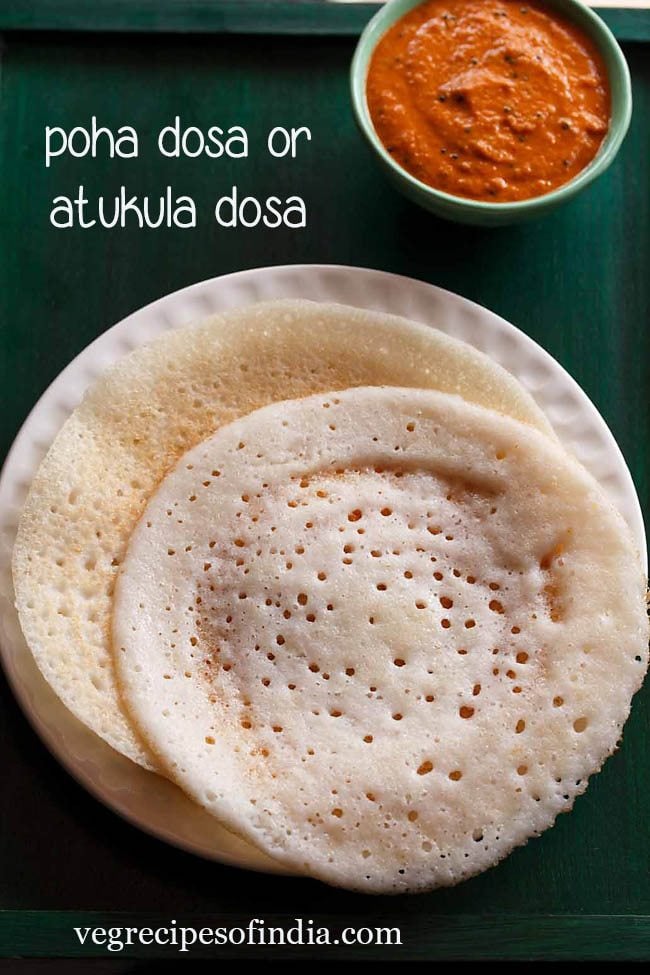
I chanced upon this atukula dosa decades back in Chandra Padmanabhan’s cookbook: “Simply South: Traditional Vegetarian Cooking”. Since then I have been making them often.
There are a few variations in making this recipe. What I share is an Andhra Style Poha dosa.
The method to make poha dosa is slightly different than the one for regular Dosa. Here the rice and poha are soaked in buttermilk. Then ground and fermented for 4 to 5 hours.
In fact, I like these dosas so much that I usually pair them with tea or coffee. When I made the dosas this time, I served poha dosa with red amaranth sambar and sesame coconut chutney.
These avalakki dosa remain soft even after some hours. Thus making them excellent for a tiffin box snack with a side of some dry powdered chutney like an Idli Podi. You can also pack for lunch or for short journeys.
While cooking them you can cook one side or both sides. They make for an excellent weekend or Sunday breakfast or brunch.
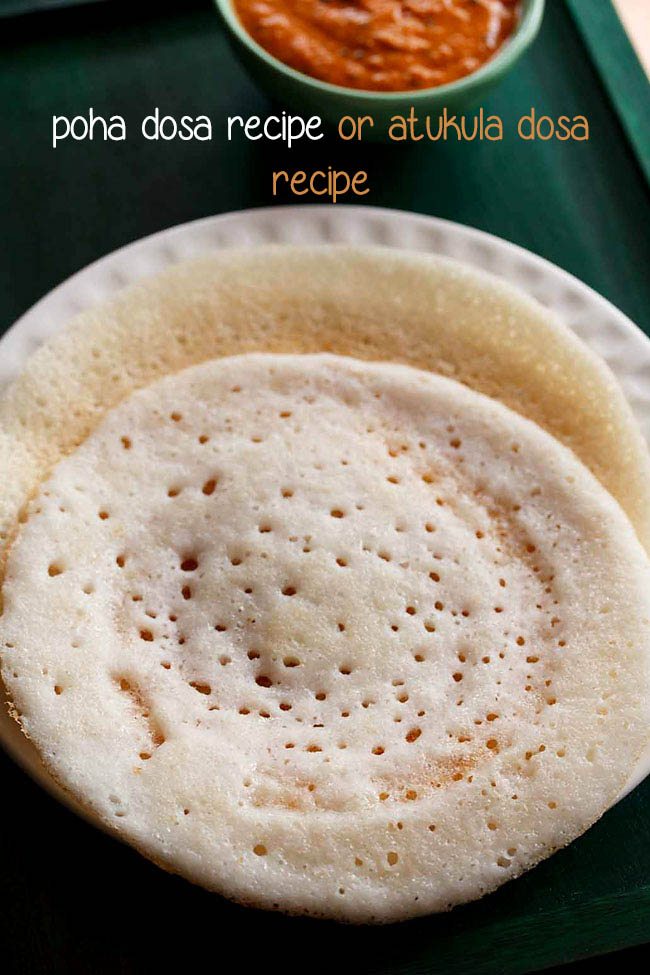
How to make Poha Dosa
Making Aval Dosa Batter
1. In a bowl, take ½ cup fresh curd (yogurt) and 1 cup water. Mix very well with a wired whisk to make buttermilk.
Don’t use sour curd as by the time the batter is fermented it will become very sour.
Alternatively you can use 1.5 cups of buttermilk.
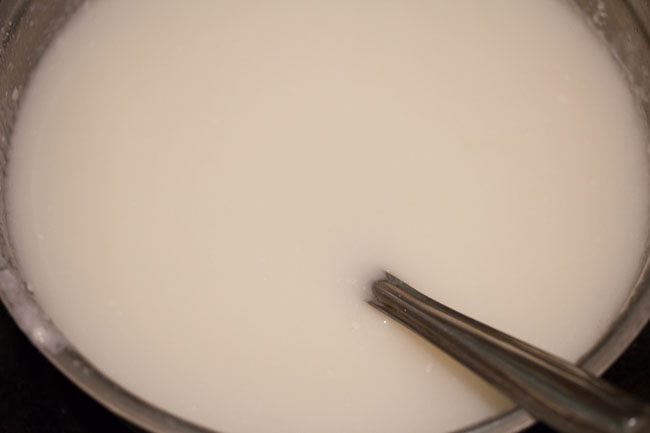
2. In a bowl, take 1 cup idli rice (parboiled rice) or regular rice like sona masuri or parmal rice.
Also add ½ cup thick poha (flattened rice) and 2 tablespoons urad dal (husked black gram).
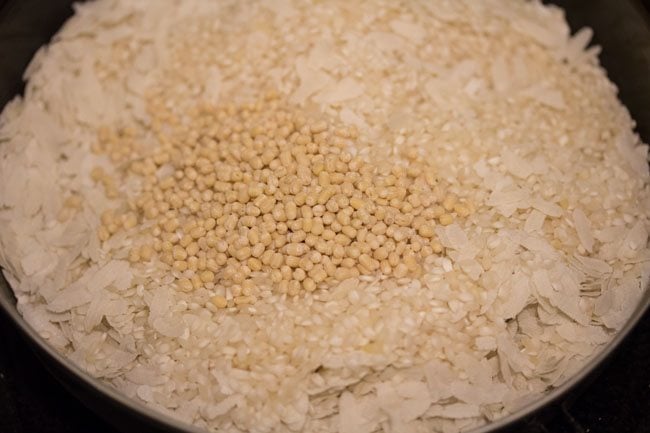
3. Rinse the rice, poha and urad dal a couple of times with fresh water. Then drain all the water.
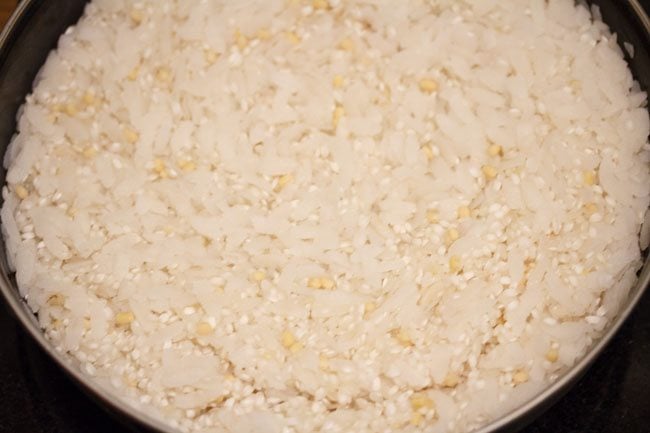
4. Now pour the prepared buttermilk (curd+water mixture) in the rinsed rice, poha and urad dal.
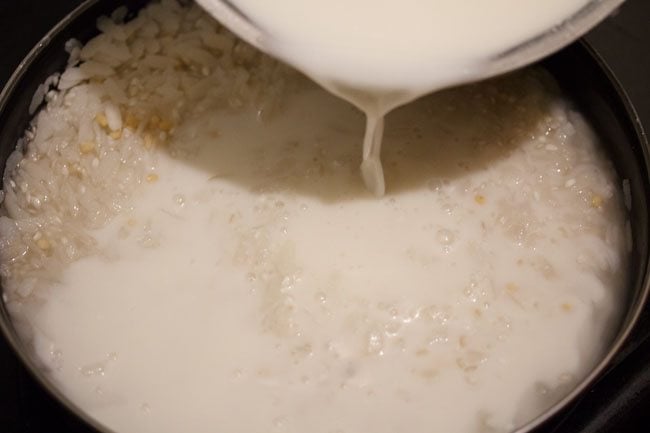
5. Gently stir the mixture.
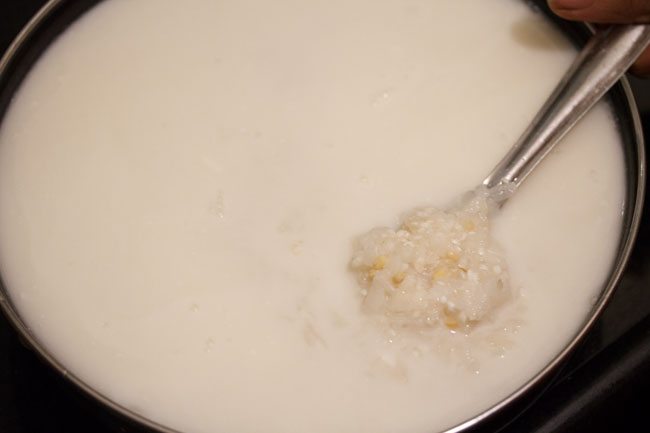
6. Soak the rice, poha and urad dal in the buttermilk mixture for 2 to 3 hours.
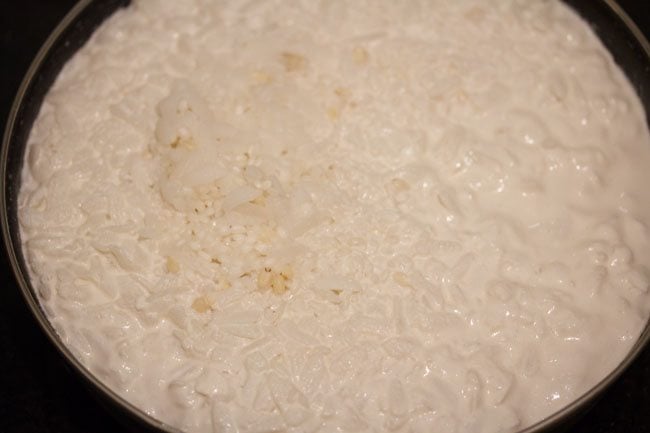
7. Drain and reserve the soaked liquid. Add the soaked rice, urad dal and poha to the blender jar.
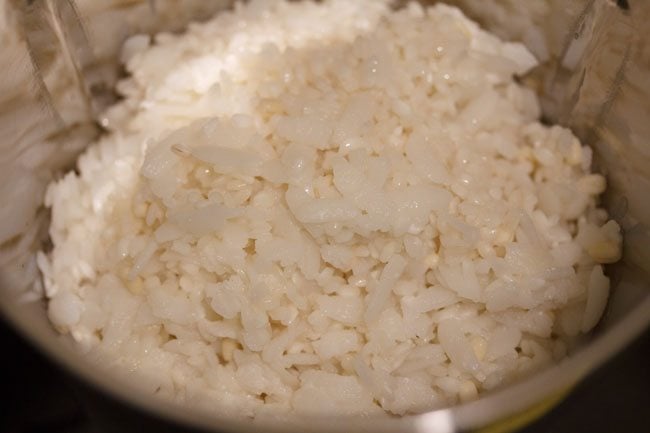
8. Grind or blend to a smooth batter using all of the reserved soaked liquid.
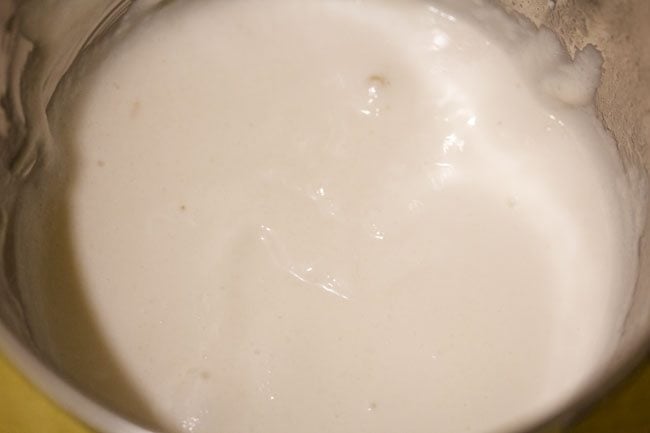
9. Remove the batter to a bowl and add ¼ teaspoon baking soda and 1 teaspoon salt.
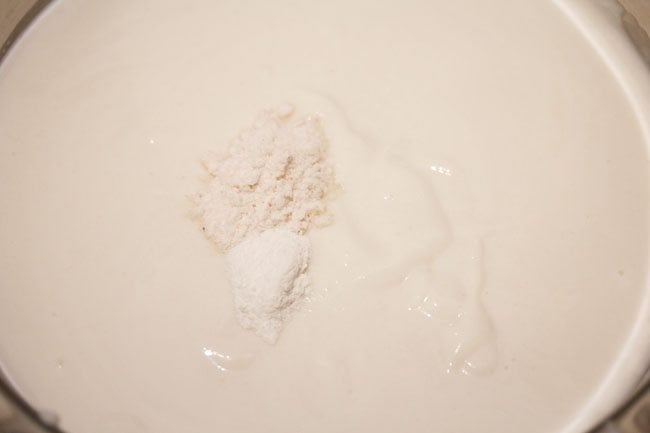
10. Mix well.
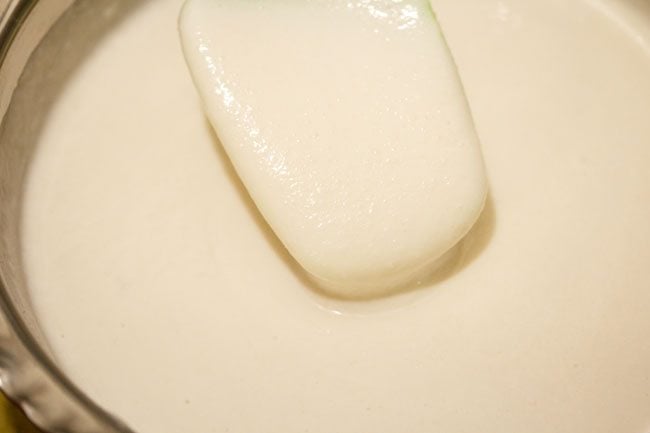
11. Ferment for 4 to 5 hours or as required. The batter should have a nice sour aroma.
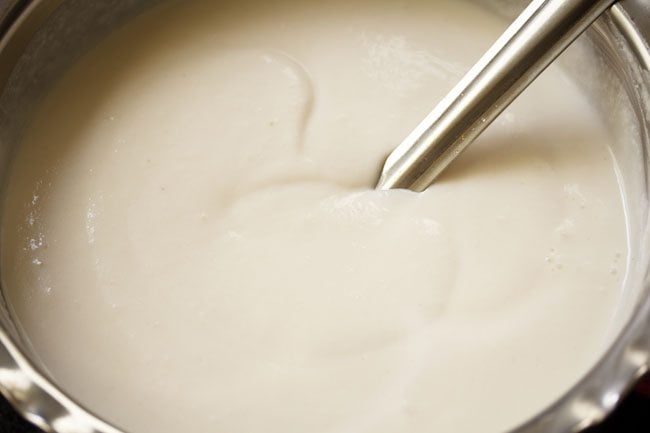
Cooking poha dosa
12. Heat a tava or griddle or a cast-iron skillet. Brush the pan with some oil. You can also spread the oil with an onion halve dipped in some oil or with a kitchen paper towel that has been folded and dipped in a bit of oil.
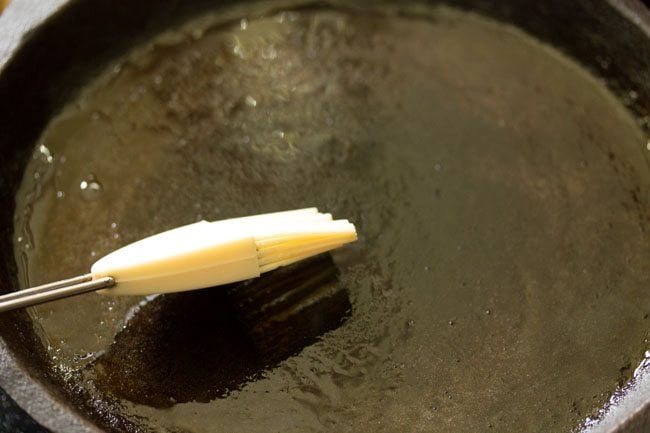
13. Take a ladle of batter and pour it on the pan. Keep the heat to low or medium-low so that you are able to spread the batter evenly.
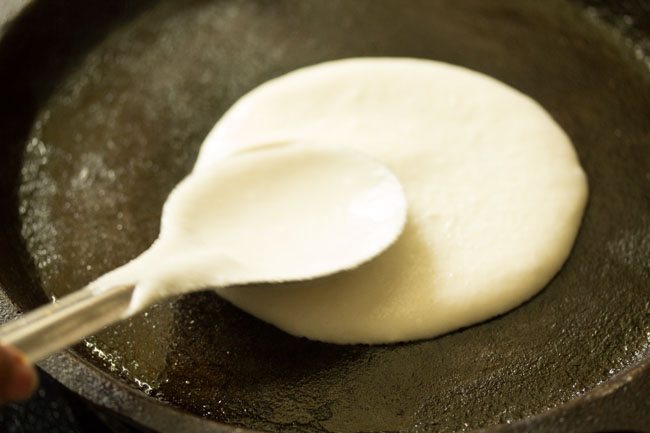
14. Starting from the center, spread the batter in a circular motion with the back of a spoon.
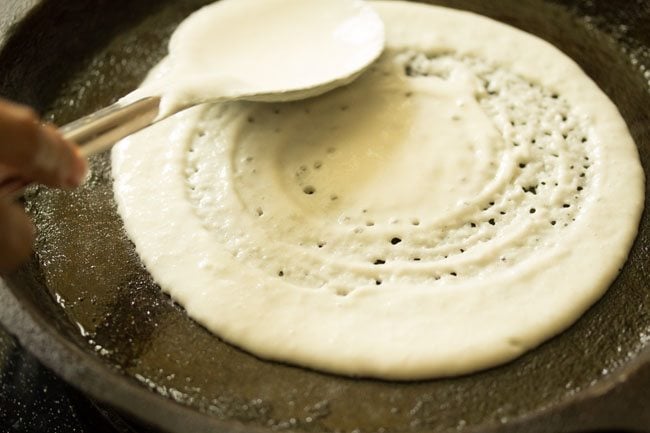
15. Make a slightly thick dosa and not thin like the regular dosa.
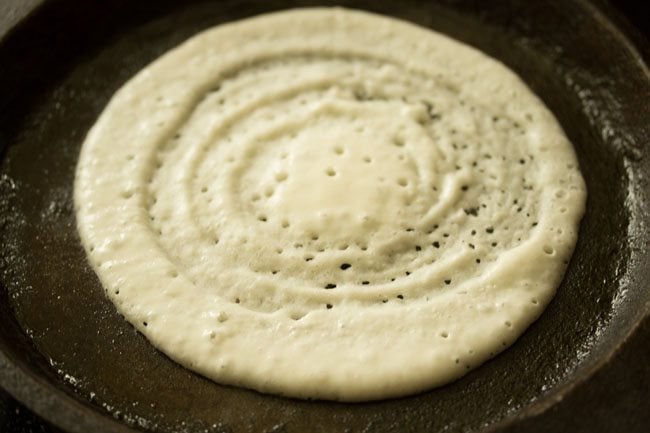
16. Drizzle oil around the edges and in the center.
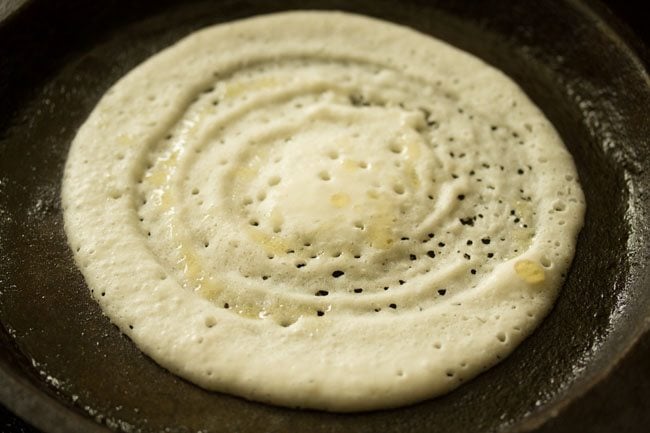
17. Cover the dosa with a lid.
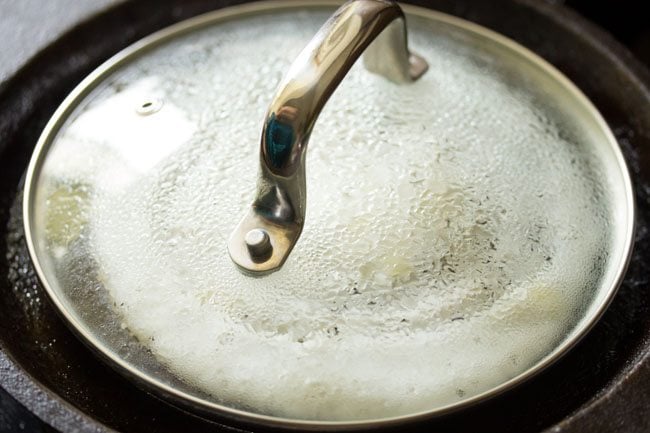
18. Cook them for 1 to 2 minutes or till the base is cooked and crisp and the top is soft and spongy.
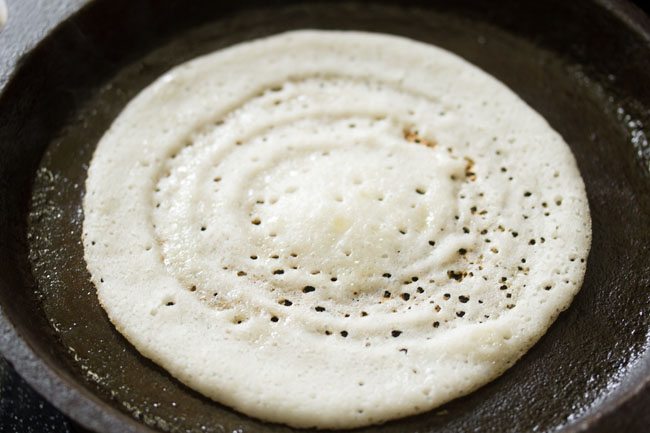
19. Flip the dosa and you can cook the other side if you want. Spread the oil which we had drizzle on top with a spoon.
You can choose to cook just one side or both sides of the dosa.
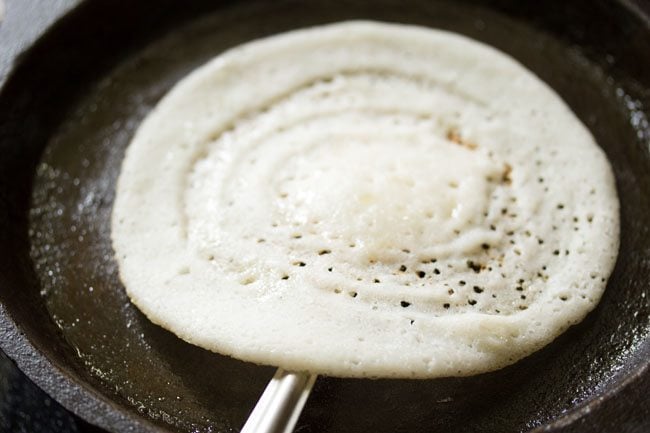
20. Similarly, make the rest of the dosa with the remaining batter. Refrigerate any leftover batter for 1 day. Don’t store the batter for more than 1 day as curd is used in the recipe.
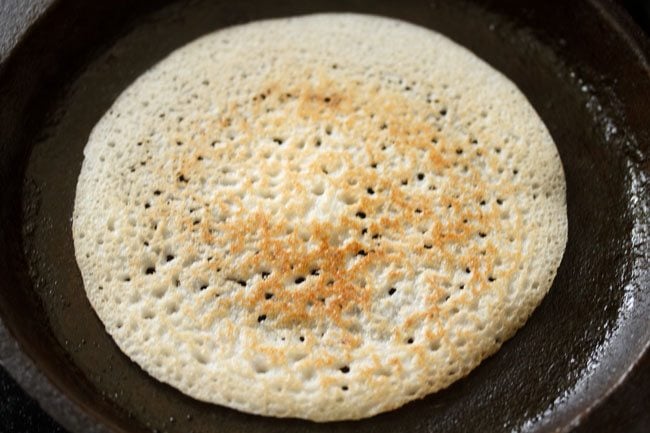
Serve Poha dosa hot or warm with coconut chutney or sambar. It can also be served with other chutney varieties like onion chutney, tomato chutney, peanut chutney, ginger chutney or idli podi.
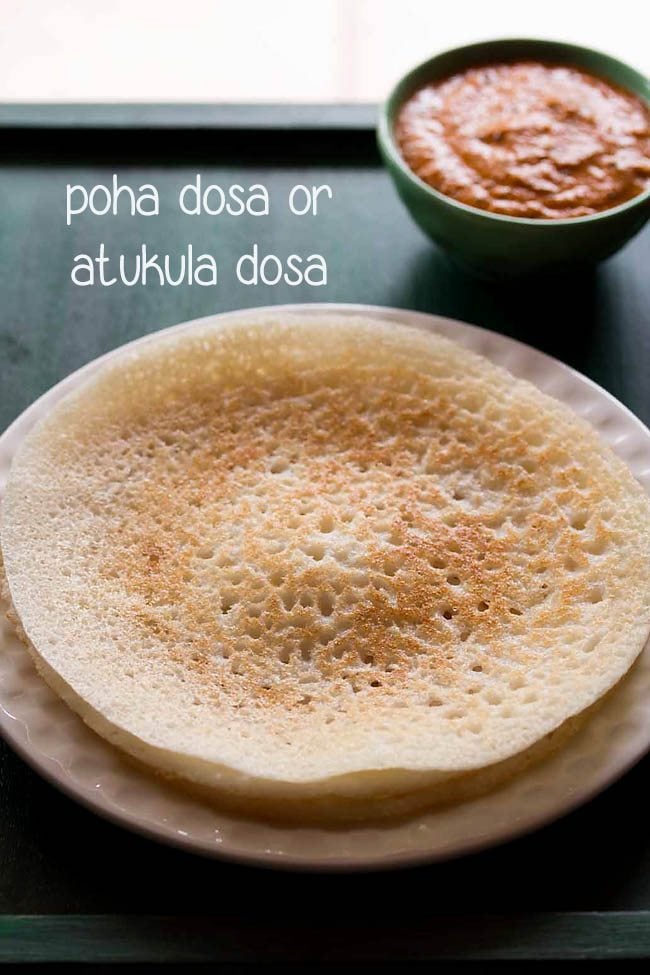
More tasty Dosa varieties:
Please be sure to rate the recipe in the recipe card or leave a comment below if you have made it. For more vegetarian inspirations, Sign Up for my emails or follow me on Instagram, Youtube, Facebook, Pinterest or Twitter.
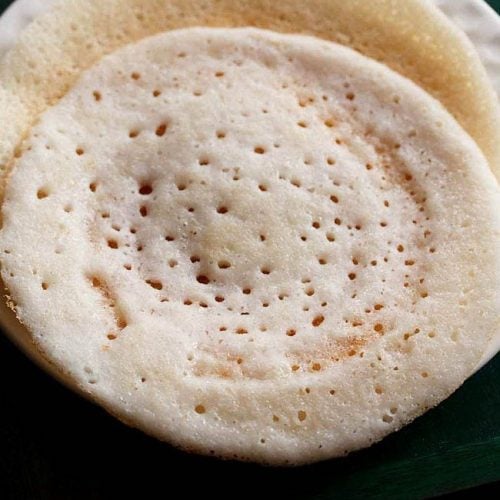
Poha Dosa | Atukula Dosa
Ingredients
- 1 cup idli rice or parboiled rice or regular rice like sona masuri rice, parmal rice – 200 grams
- ½ cup thick poha (flattened rice or parched rice) – 50 grams
- 2 tablespoons urad dal (husked black gram)
- ½ cup Curd
- 1 cup water for mixing with curd
- ¼ teaspoon baking soda
- 1 teaspoon salt or add as per taste
- oil as required
Instructions
Making aval dosa batter
- In a bowl, take fresh curd (dahi or yogurt) and water. Mix very well with a wired whisk to make buttermilk. Don't use sour curd.
- In an another bowl, take idli rice or parboiled rice or regular rice like sona masuri rice, parmal rice. Also add thick poha (flattened rice) and urad dal (husked black gram).
- Rinse the rice, poha and urad dal a couple of times with water. Then drain all the water.
- Now pour the prepared buttermilk (curd+water mixture) in the rinsed rice, poha and urad dal.
- Gently stir the mixture.
- Soak the rice, poha and urad dal in the buttermilk mixture for 2 to 3 hours.
- Drain and reserve the soaking liquid. Add the soaked rice, urad dal and poha in the blender jar.
- Grind or blend to a smooth batter using all of the reserved liquid.
- Remove the batter in a bowl and add baking soda and salt. Mix well.
- Ferment the batter for 4 to 5 hours or as required.
Cooking poha dosa
- Heat a tava or griddle or a cast iron pan. Brush the pan with some oil.
- Take a ladle of batter. Spread in a circular motion with the back of a spoon. Make a slightly thick dosa.
- Drizzle oil around the edges and on top of the dosa. Cover the dosa with a lid.
- Cook poha dosa for 1 to 2 minutes or till the base is cooked and crisp and the top is soft and spongy.
- Flip the dosa and you can cook the other side if you want.
- Similarly, make the rest of the avalakki dosa with the batter.
- Serve poha dosa hot with coconut chutney or sambar.
- Any leftover batter can be refrigerated for 1 day.
Nutrition Info (Approximate Values)
This Poha Dosa post from the blog archives first published in May 2012 has been republished and updated on 22 July 2021.












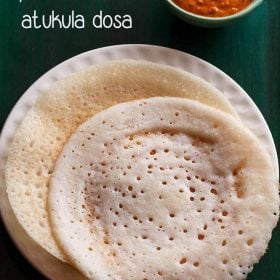
Nice
Hi Dassana,
My compliments for posting such a wide variety of recipes in such an engaging and reader friendly way. This website is my default for checking out new recipes, precisely for these reasons.
After going through the comments, I modified the dosa recipe by adding methi seeds and soaking overnight. I also added around 1 tbsp jaggery to the sesame chutney.
Turned out awesome! The combination is finger licking good! Thanks so much and keep up the good work!
hi hamsa, thank you very much. glad to know that you find the layout reader-friendly. generally, we get comments only the recipes and very rarely on the layout or presentation etc. so when feedback comes on the layout or presentation, it feels nice and good.
jaggery in sesame chutney is an awesome combination. i can gauge the flavors and taste. i should also try. thanks for sharing.
most welcome and happy cooking.
Thank you and my pleasure! In fact I really like how you weave in your personal experiences while sharing recipe facts. It makes the recipe so much more readable!
thank again hamsa. i try to add personal experiences but sometimes it is just not possible due to the complexity of the recipe. welcome and wish you all the best.
I have methi seeds and was going to add some to aid in the fermentation. How much should I add? Do I grind them with the rice after soaking?
Thanks!
you can add methi seeds. 12 to 15 methi seeds can be added. yes grind with rice after soaking. you can soak with either urad dal, rice and buttermilk mixture.
Tried this week. We as a family enjoyed the Poha Dosa!! Thank You
Welcome Mythili
Hi! Dasanna im lil bit confused . U have written fr fermentation u have to keep the batter fr 4 to 5 hours. But if i keep the batter overnight will the poha batter b more sour. Pls reply
asha, for poha dosa the batter can be kept for 4 to 5 hours. you can also keep overnight. if you keep the batter overnight it wont be sour. after 4 to 5 hours of fermentation, the batter does not have the typical sour aroma. since curd is added, there will be some sourness, but since the fermentation time is less, there will be some sweetness in the dosa. but if you keep for overnight, the batter does not become sour. also fermentation depends on the temperature. since winters are going on, you can keep the batter overnight or for some more hours.
Hi ,I have a doubt …we must need to use baking soda or we can skip it…bcoz I don’t want to use baking soda…
If I will not use soda ,the dosa will come perfectly… Plzz give fast reply…I am waiting…
baking soda makes the dosa more softer and porous. if you want you can skip also.
Thank you for sharing a healthy and tasty recipe,i will try it out.
Welcome Emon
Can we omit the buttermilk and use just water…… as my son is allergic to milk and curd
Sirisha, yes you can do this way. but for some sourness, you can add 1 tablespoon lemon juice to the poha dosa batter.
Suppose to use curd or buttermilk..???
In ingredients section its mentioned fresh curd; while recipe method its buttermilk that is being mention..!!!
Bit Confuse.. waiting for your reply to try this one (recipe)
i have used curd. i have mixed the curd with water and hence called it as buttermilk in the post. just mix the curd with water and then soak the rice, poha and urad dal in it. rinse all the ingredients before soaking.
It was a nice and great recipe
Hi friend ? Am visiting ur blog for first time. Moment I saw ur recipie for poha dosa I tried it. Have a doubt friend. Hope yo will clarify it. I fermented the batter for 6 hours but I dnt find the batter puffing up as normal dosa do. Did I go wrong somewhere? Please lemme know what should I do and how many days can I use the batter?
this batter does not ferment and double like the normal dosa. you have not gone wrong anywhere. you can keep the batter in the fridge for 2 to 3 day and use it whenever required.
Thanks for your reply ☺️☺️☺️ But I guessed since my place is too cold it’s not fermenting and kept it outside for more than 12 hours. I dnt refrigerate it. Can I use now ????? Keeping the batter outside for long time causes any health issues???
okay. keep in the fridge. do check how the batter smells. it should have a faint sour aroma. if it smells bad than you will have to discard it.
First, thank you so much for your excellent and beautiful website. I love it!!! Your recipes are delicious and I use them often.
When making this poha upma, what grade of poha do you recommend? I found thick, thin, medium and others at my store and wasn’t sure which to choose. Would you give us an education on poha?
Many thanks again. You are a treasure.
thanks a lot janis. its thick poha. i will also update in the recipe. you can also use medium poha but don’t use thin poha. may be i should write a post on different types of poha 🙂
Hi, thanks for the wonderful receipes, i have a doubt, for poha dosa we need to use sour curd? Only 4-5hrs fermentation is required? Plez …..
you can use fresh curd also. yes this much time is enough.
Hi dasana, after a short gap, am writing to u…. Exam time…bit busy…
Would like to share the way I make this type of dosa… Rice n poha 1:3 soak 4 to 5 hrs n add 1/4 part sabudana or tapioca… No curd or buttermilk… Cumin n fenugreek seeds a few… Grind ferment overnight…
In cold weather it takes more time to ferment, in summers… No problem wt fermentation… As urad dal is not added. Soft spongy texture can be got by cooking on low flame n covering dosa with a plate..
Loved malpua recipe… Bye
all the best sneha for your exams. what is this dosa called. i have noted down the ingredients and will give a try.
Hi dasana, it is the same dosa, call it poha,or soft or set dosa. We at bangalore call it medu dosa….medu in kannada is soft. some times to fasten the process of fermentation, we add curd while grinding. Sabudana n poha together render the softness……by the way, my children r writing exams…so busy me, but then I do check the new entries to ur blog everyday.
Bye.
thanks sneha for sharing the info. i have had set dosa many times. but never heard of medu dosa. take your own time. exams are more important 🙂
Hi dassana
I soaked the rice, poha in the buttermilk (2cups) I. E. 1cup=250ml. After 1.5hr, poha absorb the buttermilk .so, I added the water in it to soak few more hours. Please help me out. I have done any mistake by adding water. Thanks a lot.
poha will absorb the buttermilk. but still there will be some buttermilk. there was no need to add any water. now what you do is strain the mixture. reserve the excess buttermilk. while grinding, add the buttermilk as required.
As i am one of the frequent visitors of your website, i definitely will try it in my kitchen. Thank u. keep posting variety Andhra yummy dishes. In all my rice related dishes, i generally use unpolished rice for keeping up the levels of B complex in food.
thanks jhansi for the feedback. even i use unpolished rice for dal and sambar and veggie dishes. only while making biryanis and pulaos, i use basmati rice.
Hi dassana
I tried the mysore-masala-dosa and onion rava dosa.they came out well. My husband loved it. You mention basmati rice in recipe. Instead of basmati rice Shall I use dosa rice or idli rice or sonamasoori rice. Please help me. Thanks a lot
welcome sarika. thanks for giving positive reviews on dosa. you can use any regular rice. sona masoori rice will be fine.
Hi dassana,
yesterday i tried this recipe.it was just awesome,thank you so mush to share such a nice recipe with us.god bless u
welcome debarati. thanks for your positive feedback and blessings. keep visiting.
Thanks for the awesome recipe.I tried it out and it turned excellent. So couldn’t resist myself without commenting.This is the first time im writing though i tried many recipes from various websites.
welcome harikavijay. glad to know that you liked the recipes from this blog.
Thanks for the awesome recipe.I tried i out today and it was excellent. Couldn’t resist myself without writing the comments.This is the first time im writing though i tried a lot of recipes from various websites.
welcome harikavijay. glad to read your positive feedback on recipes.
Hi,
You have mentioned Poha in the recipe. Is it the thin or thick variety?
the thick variety. however thin variety of poha can also be used.
It came good. Soft and tasty…. thanks a lot…. my hubby had well and we both had a sound sleep 🙂
welcome sara.
Hi…
very clear explanation. good job. i wished to eat poha dosa with that chutney also. looks so soft. As soon as read this i soaked the items to prepare for dinner. I didn’t have grinder and with mixie am going to do. Is this same proportion to grind in mixie? Then another one doubt, If i mix the baking soda once means after left over batter can i keep it in fridge and make it use for breakfast? thanks in advance.
yes the same proportion. after mixing baking soda, you can keep the batter for the hours mentioned in the recipe and then keep in the fridge. but use the batter in one day.
Tried your jhatpat dosa recipe although I used slightly different proportions of ingredients and methi seeds instead of urad dal.Fantastic !! Soft, sumptuous and spongy dosas. Very easy to make with very little oil required ( almost non existent if one wishes except some required for the initial seasoning of pan) so very healthy. Thanks
welcome shilpa. my thanks to you for this detailed feedback on poha dosa as it help other readers too.
I am first time visitor here. Loved your blog and the recipe. I am sure going to try it. My folks add a couple tsp of methi seeds for avalakki dosa.
I also liked your way of responding to each comment, shows that you r in touch with your readers. Keep up the good work!
thanks vasudha. readers queries and tips are always welcome. thanks for sharing your tip of adding methi seeds.
Hi Dassana
Great blog,wonderful recipes. I made your dosa and chutney and they came out beautiful. My family loved it. In fact your mail came just as I was serving breakfast! Thank you so much.
thanks poornima.
Hi Dassana
Great blog,wonderful recipes. Made your dosa and chutney. Came out beautiful. My family loved it. I actually saw your mail just as I was serving breakfast! Thanks so much.
Madam,
Beautiful poha dosa. I was searching for recipe of regular Dosa. Instead I got this.Where is recipe of regular Dosa?
on this link you will get a detailed post to make dosa batter as well as dosa.
https://www.vegrecipesofindia.com/masala-dosa-recipe-how-to-make-masala-dosa-recipe/
Sorry,Sorry on some other blog I could not find Dosa recipe and inadvertently I have stated that on your site I could not get it.Sorry again and thanks for taking to much trouble for giving good recopies with beautiful photos.They are giving the feeling that it is just kept on dining table.
In the morning we had breakfast of poha dosas and coconut chutney prepared as shown by you. Poha dosas just came out as shown in your pictures. Chutney was also as we get in south Indian hotels.Thanks.
thats nice to know shrikant. glad to know you & your family enjoyed the breakfast.
Hi,
Just recently i came to know about your blog.. and its simply awesome. You are doing a excellent job.. Keep posting new recipes and rock on!!
The very first item i tried from ur blog was this poha dosa. Since the climate is my place is very cold now, the batter didn,t ferment even after keeping the batter the whole night. Morning i added baking soda and tried making dosa. But it was not up to d mark. So can you help me with any solution for it.
Thank you so in advance. I have one small request also… When ever ur posting cake recipes pls also include how to make in microwave and if possible in cooker. i don’t have oven. I just have microwave grill convection. 🙂
thanks vasundhara. the poha dosa does not require much fermentation time. did you see bubbles appearing in the batter when you added baking soda. these dosas are very soft and porous. so i guess the baking soda must have become outdated.
all the cakes, breads & pudding recipes i have posted till nov 12 have been made in the microwave oven in convection mode except for one old post of eggless chocolate cake made in a pressure cooker. there’s not much difference in baking in a regular oven or microwave oven. except for that in while baking in microwave oven in convection mode, the top browns faster.
actually while baking in a microwave oven, you have to use the convection mode. check your manufacturers’s guide for the details. i will be writing a separate post on this topic as i get a lot of queries regarding the same.
Hi dassana,
Thank you so much for the reply. I thought the fermentation is like for normal dosa where the batter will rise 🙂 Anyways will try again and let you know sure for the results.
Mine is microwave+grill only. So in this case, do i need use combination?? No is it.. I just have to use microwave option only right ?? 🙂
Whats the meaning of your name.. Its very different and very nice
next time do let me know the results for the poha dosa. try reading online on what can be made in the microwave plus grill option. i can only think of sandwiches or patties when i hear the word grill 🙂 i don’t think cakes can be made in this option.
one reader harsha, did try the eggless orange cake first in microwave and then in microwave plus grill method. i have never used this mode, so don’t know what would be the results. i guess the only option is to make the cakes in microwave oven. you can try this eggless orange cake as it can be made in the microwave. here’s what harsha has to say on this link: https://www.vegrecipesofindia.com/eggless-orange-cake/#comment-49806
generally cake batters that need to be microwaved have a lighter and liquid consistency than the ones that are made for regular baking.
“dassana” is a buddhist word in pali language which translates to “search for insight”.
Dassana,
I have looked on to the comment, so let me try that and tell my testing and trials 🙂 “Batter for cake should be lighter and liquid” – is very important and main tip for beginners like me. Thanks a TON for that 🙂 Will update you soon after my testings 🙂
thanks vasundhara and do give the feedback.
this recipe of dosas is quite unusual, but the ingredients here cannot go wrong! I’m gonna try this out!
i made it yesterday with sambar and sesame coconut chutney and the feast was fabulous..thanks Dassana
thats great suhani and welcome dear.
gonna try it today..have kept the batter for fermentation..will soon tell u the result..
sure suhani…
hi there
i gt to know abt ur blog frm IMBB and i am just hooked on to ur blog now hehe
i want to giv this a recipe a try. is it okay to leave the batter for fermentation overnight, instead of 4-5 hours as you mentioned? that way i can easily make it for breakfast.
i also wanna try ur ragda pattice recipe as my hubby loves them.
thanks in advance dear. you are doing a brilliant job. kudos!
thanks ayesha. yes you can keep the batter for fermentation overnight. in this scenario then don’t add the baking soda. in the morning before making the dosas add the soda and mix really well. do try the ragda patties recipe.
thanks for such a prompt reply dear. will b making this soon. And ragda pattice is goin in my recipe cook book for iftaars as ramadhan is round the corner 🙂
welcome ayesha. on a side note, i just love the goodies that are made during iftaars 🙂
then ur most welcome. plz join us some day if u happen to be in bangalore 🙂
i am a north indian(delhiite), married to a bangalore guy and i love the simplicity of south indian food 🙂
and i meant cook book* in my last comment 😀
thanks ayesha for the invitation. sure… would love to visit you when i travel to bangalore.
i will edit your comment to reflect the changes 🙂
Whats the role of buttermilk ? Can we soak it in water instead of buttermilk ? my kid is allergic to milk .
buttermilk helps in the fermentation process. it also imparts its typical taste and flavor to the dish. you can make it without buttermilk also. in this case ferment for a longer period of time or overnight.
Hi Dassana
A very gr8 recipe, but a little confusion, I need to soak the rice,poha and dal in the buttermilk mixture and then drain tthe liquid and how to use the liquid again. Should i make a batter and again soak it in the drained liquid.
If u could pls explain then i will be making this tomorrow.
Thanks in advance
Take care
Sunita
thanks sunita.
you have to soak the urad dal, rice and poha in the buttermilk mixture.
then strain in a strainer and collect the strained liquid in a bowl or pan. while straining keep a pan below the strainer. add the soaked dal, rice and poha to the grinder. keep on adding the strained buttermilk mixture in between while grinding the batter till you get the consistency of a dosa batter. discard the leftover strained liquid.
after making the batter, you don’t need to soak the batter in the strained liquid.
hope the method is clear and you make great fluffy poha dosa at home 🙂
Yes now its clear thanks for the quick reply dassana
Take care
sunita
First time on your space Dassana and I must say , what a clean, neat and admirable work you have done. Love it here, with all the recipes simple and straight from your heart ..
Glad to follow you, want to see more recipes coming 🙂
thanks a lot nupur for such encouraging comments.
hi dassana
made the dosas as said yesterday and they turned really well. thanks for the recipe
thats great to know. thanks uma.
hey am going to try ths tomorrow, the recipe looks intresting
sure, do give the feedback uma.
you are on a posting roll!:) love how porous these dosas came out.
This one looks like one excellent dosa recipe…simply superb!
Nice to know a new variety of Dosa. Is there a possibility to avoid Soda as we are not used to this and not sure of the tolerance level for human consumption.
yes you can avoid the baking soda. but the texture won’t be spongy or porous, yet still the dosa will taste good.
Looks so perfect and spongy! My MIL makes these and I just love them smeared with some ghee and with coconut chutney. Just soaked the rice, poha and dal for breakfast tomorrow, hubby will be mighty pleased:)!!
Yeh, these are common in Andhra and more so in Mysore and Banglore and the suburbs. In KarnatItaka, in Hotels this is very popular. They call it set-Dosa in the hotels. A set of 4 such thick dosas are served with Samabr & coconut chutney. They are very tasty and one such SET is enough for city denizens to satisfy their Lunch or the heavy Break fast.
as you have pinted out it is very easy to grind as not much udad is involved. You can do it in Mixie too.No grinder required. Yummy, the softies they just disappear in your mouth without much chewing. Good for a hasty work-lunch. Kudos to you for propagating this simple to make and at the same time healthy and rich food.
oh… i always thought that the set dosa is different from the poha dosa. i have had set dosa many times in bangalore. i know one set is enough 🙂
yes, it is healthy and light in the summers too…
Looks so soft…luv ur version. Lovely clicks!
Excellent recipe! When you say cooking soda, do you mean baking soda? Also can you pl. send me the recipe for sambar, that goes with this dosa recipe. Always enjoy the mouth-watering, delicious recipes that you post. Keep up the good work.
yes it is baking soda and thanks katie.
the next recipe to be posted will be the red amaranth sambar recipe.
These look like pillows made of clouds. So soft and nice.